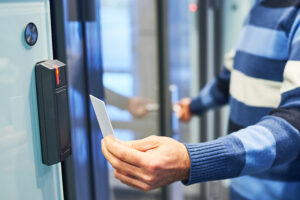Protecting commercial and government buildings (and more recently, community-focused buildings) often involves multiple lines of defense. You can utilize things like security cameras, professional patrols, alarm systems, metal detectors, and more. All of these options can be useful in certain settings. And they may even be part of a larger security plan that includes multiple safeguards at once. But they shouldn’t be used as a replacement for physically shoring up your location with secure building enhancements like bulletproof security.

Bulletproof security includes building upgrades like windows, doors, entryways, and countertop systems that are made of reinforced materials like acrylic, polycarbonate, laminated glass, and glass-clad polycarbonate. These panels are designed specifically to withstand certain levels of ballistic impact, making it difficult for intruders to break through barriers to commit theft, vandalism, or potentially violent acts.
If you’re looking to improve your building’s security, here’s why you should prioritize bulletproof security over other options – or at least include them as part of a larger safety and security plan.
Bulletproof Security Enhances Other Lines of Defense
When designing a security plan for a building or facility, you don’t necessarily need to choose between bulletproof security and other solutions. In fact, these protective structures work as the perfect complement to other lines of defense. They can work as one safeguard within a larger system that may include elements like cameras, fences, or even security patrols.
What a bulletproof window or door provides is basically a hard layer of redundancy around a building’s exterior or a secure area inside the facility. This can make it more difficult for an intruder to physically get past the initial entry point or layer of security. Even if they have a weapon and intend to break through by force, they should not be able to breach the door or window immediately, like they may be able to with traditional glass windows and doors.
This provides a couple of important benefits. First, it tends to have the effect of deterring violent acts from occurring in the first place. Intruders are often looking for easy targets, so installing barriers that are difficult to break through can make them switch targets or rethink their plans altogether.
Even in the cases where an attempt is made, bulletproof security can dramatically slow down their efforts. Although no material can withstand ballistic impact indefinitely, reinforced materials like glass-clad polycarbonate are significantly more difficult and time consuming to break through than traditional windows and doors. So would-be intruders are much less likely to successfully breach an entrance or secure area before security patrols or first responders are able to arrive. And it gives employees and others in the building more time to get to safety or protect themselves if needed.
When used in tandem with these other security solutions, bullet resistant doors and windows essentially provide more time and important safety considerations. For example, say an intruder is trying to break into a financial institution after hours. Security cameras alone may help to alert the authorities that a break-in is occurring – but without bulletproof security, the assailants may be able to get away before help arrives. The extra layer of protection can improve the likelihood of a camera, alarm system, or patrol actually helping to catch intruders in the act. It can also minimize damage to persons and property in the meantime.
A Safe Room Is The Ultimate Internal Defense for Commercial Structures
Bulletproof security doesn’t just include external doors and windows or entryway and countertop systems, though these solutions can be incredibly beneficial to a wide array of commercial and public entities. The concept also extends to architectural saferooms.
These structures are essentially rooms or enclosures made of bullet resistant materials that are constructed inside various buildings where extra protection is needed for those inside. They may include bullet resistant doors, windows, framing systems, glazing materials, and opaque armor. In many cases, they can even be retrofitted to existing structures, so you can enjoy this extra layer of protection without the need for a huge new construction project.
Their purpose is to greatly enhance protection from external threats and situations until authorities can arrive to provide assistance or diffuse the situation. So if a building faces a potential intruder, which you may learn about from other security features like cameras or alarm systems, the team can use the protection of this ballistic safe room to avoid the threat until first responders arrive.
The ultimate goal with any security plan is to keep employees, customers, and any other visitors safe from harm. So adding a bullet resistant enclosure may be the perfect way to accomplish this important goal — especially when combined with other security solutions as part of an overall plan. Bullet resistant enclosures can even be used in conjunction with other types of bulletproof security like exterior doors and windows or counterline systems. This can provide a complete security plan that protects both people and property throughout the facility.
If you’re ready to enhance bulletproof security at your facility, contact Insulgard to discuss your options. We offer a wide array of bullet resistant solutions that can be customized to the needs of your business, organization, or government building. From doors and windows to entryway enclosures and counterline systems, our products are designed and tested to ensure the highest quality standards in the industry. Our team works with clients throughout the process to offer expertise and value, and we can even help you customize solutions to retrofit bulletproof security to your current location or design brand new enclosures for construction projects. Visit our website to discuss your options with a bulletproof security specialist.

